Business Strategy Report: Vodafone's Macro, Internal & Sector Analysis
VerifiedAdded on 2020/10/22
|20
|5554
|288
Report
AI Summary
This report provides a comprehensive analysis of Vodafone's business strategy. It begins with an introduction to business strategy and then delves into a PESTLE analysis of the macro environment, examining political, economic, social, technological, legal, and environmental factors influencing Vodafone. The report then analyzes Vodafone's internal environment and capabilities using the VRIO model, assessing valuable, rare, inimitable, and organizationally supported resources. Furthermore, it evaluates the UK telecommunication sector and applies the Ansoff matrix to explore strategic directions and options such as market penetration, market development, product development, and diversification. The report concludes with a summary of findings and references.
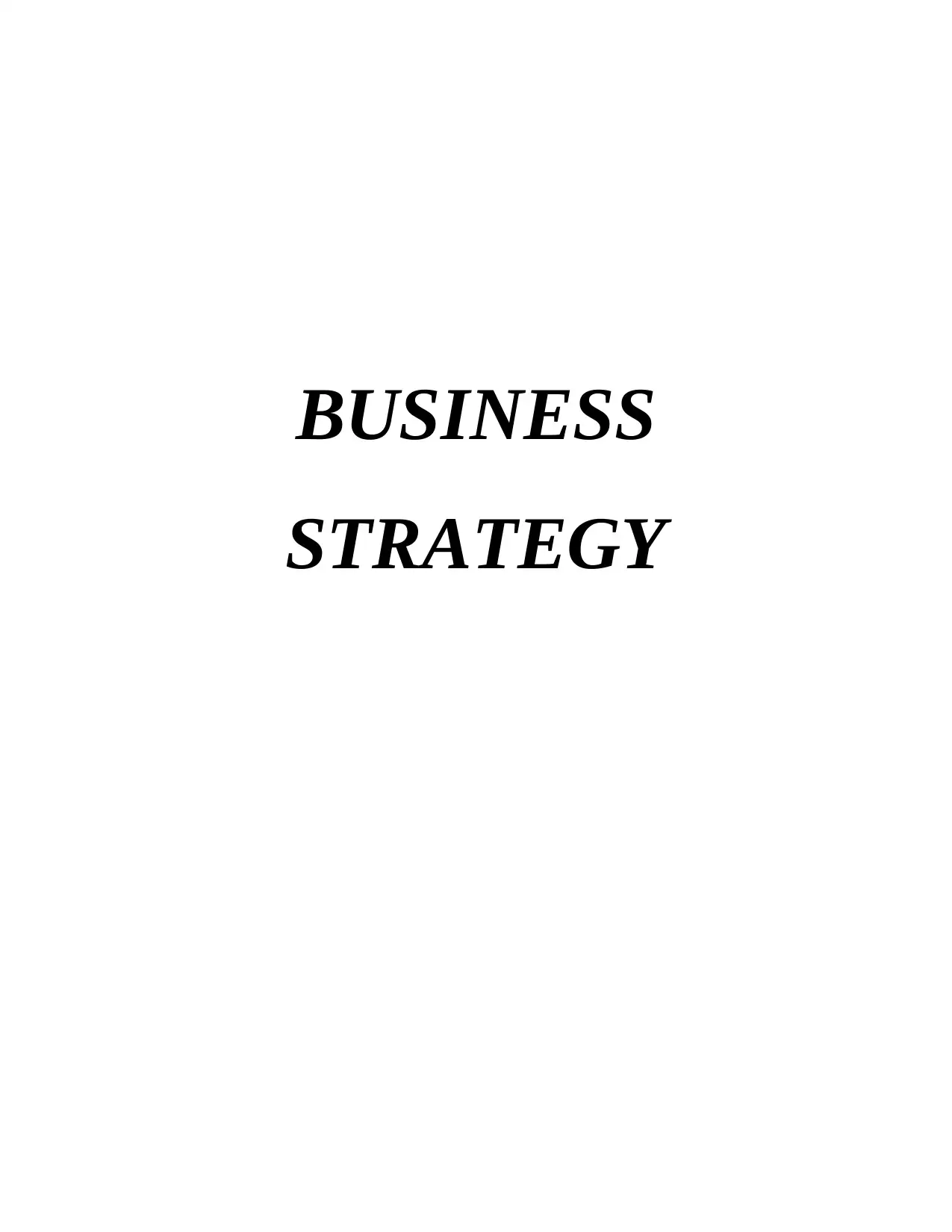
BUSINESS
STRATEGY
STRATEGY
Paraphrase This Document
Need a fresh take? Get an instant paraphrase of this document with our AI Paraphraser
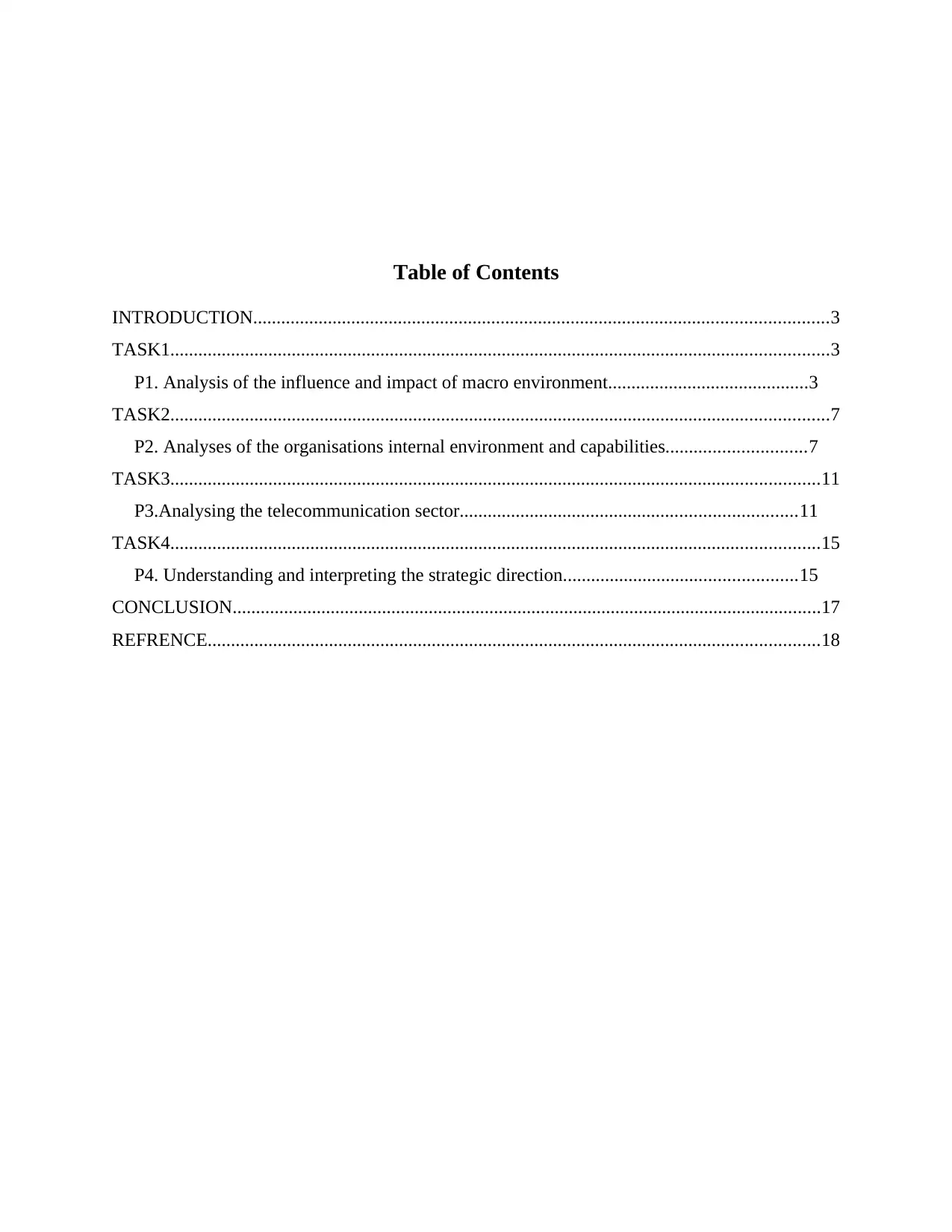
Table of Contents
INTRODUCTION...........................................................................................................................3
TASK1.............................................................................................................................................3
P1. Analysis of the influence and impact of macro environment...........................................3
TASK2.............................................................................................................................................7
P2. Analyses of the organisations internal environment and capabilities..............................7
TASK3...........................................................................................................................................11
P3.Analysing the telecommunication sector........................................................................11
TASK4...........................................................................................................................................15
P4. Understanding and interpreting the strategic direction..................................................15
CONCLUSION..............................................................................................................................17
REFRENCE...................................................................................................................................18
INTRODUCTION...........................................................................................................................3
TASK1.............................................................................................................................................3
P1. Analysis of the influence and impact of macro environment...........................................3
TASK2.............................................................................................................................................7
P2. Analyses of the organisations internal environment and capabilities..............................7
TASK3...........................................................................................................................................11
P3.Analysing the telecommunication sector........................................................................11
TASK4...........................................................................................................................................15
P4. Understanding and interpreting the strategic direction..................................................15
CONCLUSION..............................................................................................................................17
REFRENCE...................................................................................................................................18
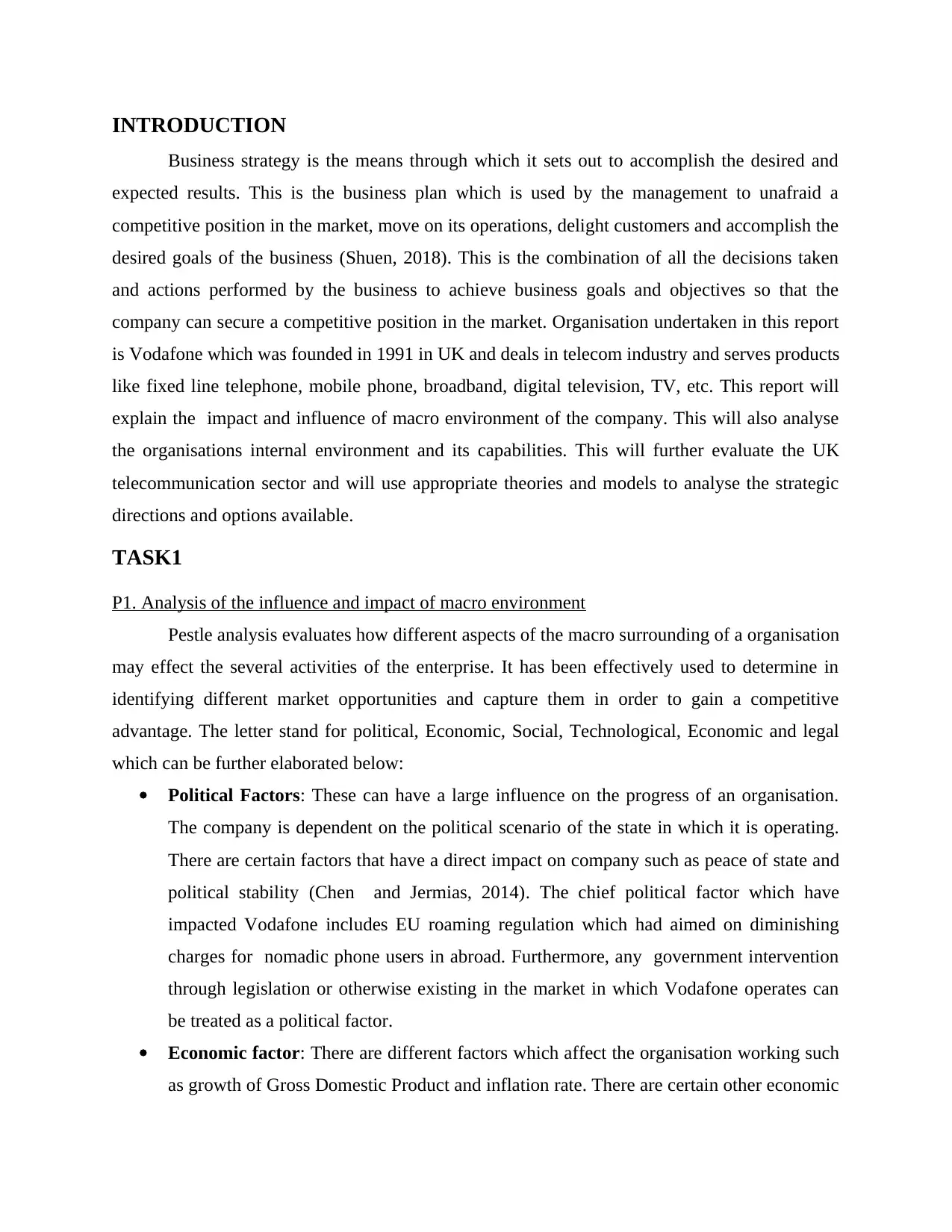
INTRODUCTION
Business strategy is the means through which it sets out to accomplish the desired and
expected results. This is the business plan which is used by the management to unafraid a
competitive position in the market, move on its operations, delight customers and accomplish the
desired goals of the business (Shuen, 2018). This is the combination of all the decisions taken
and actions performed by the business to achieve business goals and objectives so that the
company can secure a competitive position in the market. Organisation undertaken in this report
is Vodafone which was founded in 1991 in UK and deals in telecom industry and serves products
like fixed line telephone, mobile phone, broadband, digital television, TV, etc. This report will
explain the impact and influence of macro environment of the company. This will also analyse
the organisations internal environment and its capabilities. This will further evaluate the UK
telecommunication sector and will use appropriate theories and models to analyse the strategic
directions and options available.
TASK1
P1. Analysis of the influence and impact of macro environment
Pestle analysis evaluates how different aspects of the macro surrounding of a organisation
may effect the several activities of the enterprise. It has been effectively used to determine in
identifying different market opportunities and capture them in order to gain a competitive
advantage. The letter stand for political, Economic, Social, Technological, Economic and legal
which can be further elaborated below:
Political Factors: These can have a large influence on the progress of an organisation.
The company is dependent on the political scenario of the state in which it is operating.
There are certain factors that have a direct impact on company such as peace of state and
political stability (Chen and Jermias, 2014). The chief political factor which have
impacted Vodafone includes EU roaming regulation which had aimed on diminishing
charges for nomadic phone users in abroad. Furthermore, any government intervention
through legislation or otherwise existing in the market in which Vodafone operates can
be treated as a political factor.
Economic factor: There are different factors which affect the organisation working such
as growth of Gross Domestic Product and inflation rate. There are certain other economic
Business strategy is the means through which it sets out to accomplish the desired and
expected results. This is the business plan which is used by the management to unafraid a
competitive position in the market, move on its operations, delight customers and accomplish the
desired goals of the business (Shuen, 2018). This is the combination of all the decisions taken
and actions performed by the business to achieve business goals and objectives so that the
company can secure a competitive position in the market. Organisation undertaken in this report
is Vodafone which was founded in 1991 in UK and deals in telecom industry and serves products
like fixed line telephone, mobile phone, broadband, digital television, TV, etc. This report will
explain the impact and influence of macro environment of the company. This will also analyse
the organisations internal environment and its capabilities. This will further evaluate the UK
telecommunication sector and will use appropriate theories and models to analyse the strategic
directions and options available.
TASK1
P1. Analysis of the influence and impact of macro environment
Pestle analysis evaluates how different aspects of the macro surrounding of a organisation
may effect the several activities of the enterprise. It has been effectively used to determine in
identifying different market opportunities and capture them in order to gain a competitive
advantage. The letter stand for political, Economic, Social, Technological, Economic and legal
which can be further elaborated below:
Political Factors: These can have a large influence on the progress of an organisation.
The company is dependent on the political scenario of the state in which it is operating.
There are certain factors that have a direct impact on company such as peace of state and
political stability (Chen and Jermias, 2014). The chief political factor which have
impacted Vodafone includes EU roaming regulation which had aimed on diminishing
charges for nomadic phone users in abroad. Furthermore, any government intervention
through legislation or otherwise existing in the market in which Vodafone operates can
be treated as a political factor.
Economic factor: There are different factors which affect the organisation working such
as growth of Gross Domestic Product and inflation rate. There are certain other economic
⊘ This is a preview!⊘
Do you want full access?
Subscribe today to unlock all pages.

Trusted by 1+ million students worldwide
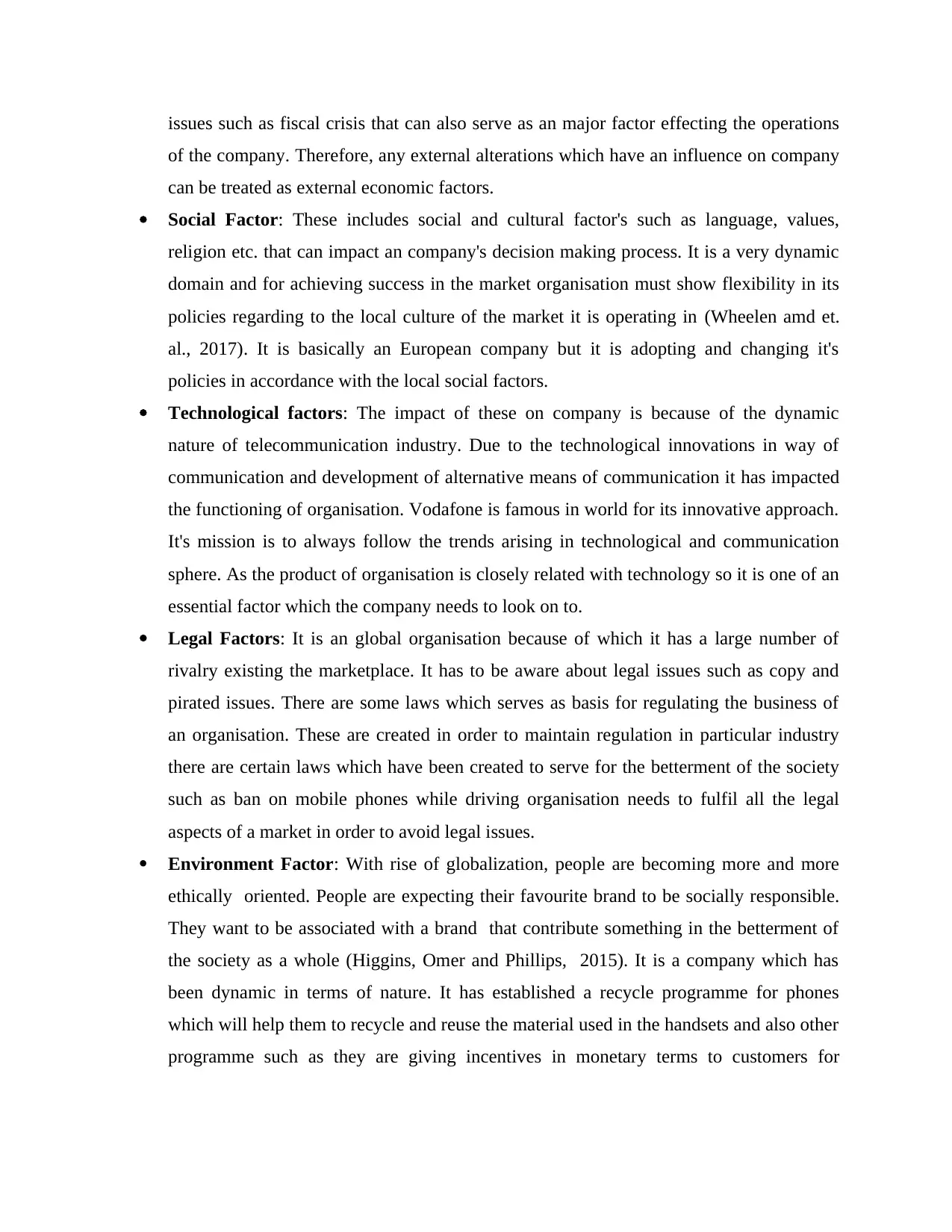
issues such as fiscal crisis that can also serve as an major factor effecting the operations
of the company. Therefore, any external alterations which have an influence on company
can be treated as external economic factors.
Social Factor: These includes social and cultural factor's such as language, values,
religion etc. that can impact an company's decision making process. It is a very dynamic
domain and for achieving success in the market organisation must show flexibility in its
policies regarding to the local culture of the market it is operating in (Wheelen amd et.
al., 2017). It is basically an European company but it is adopting and changing it's
policies in accordance with the local social factors.
Technological factors: The impact of these on company is because of the dynamic
nature of telecommunication industry. Due to the technological innovations in way of
communication and development of alternative means of communication it has impacted
the functioning of organisation. Vodafone is famous in world for its innovative approach.
It's mission is to always follow the trends arising in technological and communication
sphere. As the product of organisation is closely related with technology so it is one of an
essential factor which the company needs to look on to.
Legal Factors: It is an global organisation because of which it has a large number of
rivalry existing the marketplace. It has to be aware about legal issues such as copy and
pirated issues. There are some laws which serves as basis for regulating the business of
an organisation. These are created in order to maintain regulation in particular industry
there are certain laws which have been created to serve for the betterment of the society
such as ban on mobile phones while driving organisation needs to fulfil all the legal
aspects of a market in order to avoid legal issues.
Environment Factor: With rise of globalization, people are becoming more and more
ethically oriented. People are expecting their favourite brand to be socially responsible.
They want to be associated with a brand that contribute something in the betterment of
the society as a whole (Higgins, Omer and Phillips, 2015). It is a company which has
been dynamic in terms of nature. It has established a recycle programme for phones
which will help them to recycle and reuse the material used in the handsets and also other
programme such as they are giving incentives in monetary terms to customers for
of the company. Therefore, any external alterations which have an influence on company
can be treated as external economic factors.
Social Factor: These includes social and cultural factor's such as language, values,
religion etc. that can impact an company's decision making process. It is a very dynamic
domain and for achieving success in the market organisation must show flexibility in its
policies regarding to the local culture of the market it is operating in (Wheelen amd et.
al., 2017). It is basically an European company but it is adopting and changing it's
policies in accordance with the local social factors.
Technological factors: The impact of these on company is because of the dynamic
nature of telecommunication industry. Due to the technological innovations in way of
communication and development of alternative means of communication it has impacted
the functioning of organisation. Vodafone is famous in world for its innovative approach.
It's mission is to always follow the trends arising in technological and communication
sphere. As the product of organisation is closely related with technology so it is one of an
essential factor which the company needs to look on to.
Legal Factors: It is an global organisation because of which it has a large number of
rivalry existing the marketplace. It has to be aware about legal issues such as copy and
pirated issues. There are some laws which serves as basis for regulating the business of
an organisation. These are created in order to maintain regulation in particular industry
there are certain laws which have been created to serve for the betterment of the society
such as ban on mobile phones while driving organisation needs to fulfil all the legal
aspects of a market in order to avoid legal issues.
Environment Factor: With rise of globalization, people are becoming more and more
ethically oriented. People are expecting their favourite brand to be socially responsible.
They want to be associated with a brand that contribute something in the betterment of
the society as a whole (Higgins, Omer and Phillips, 2015). It is a company which has
been dynamic in terms of nature. It has established a recycle programme for phones
which will help them to recycle and reuse the material used in the handsets and also other
programme such as they are giving incentives in monetary terms to customers for
Paraphrase This Document
Need a fresh take? Get an instant paraphrase of this document with our AI Paraphraser
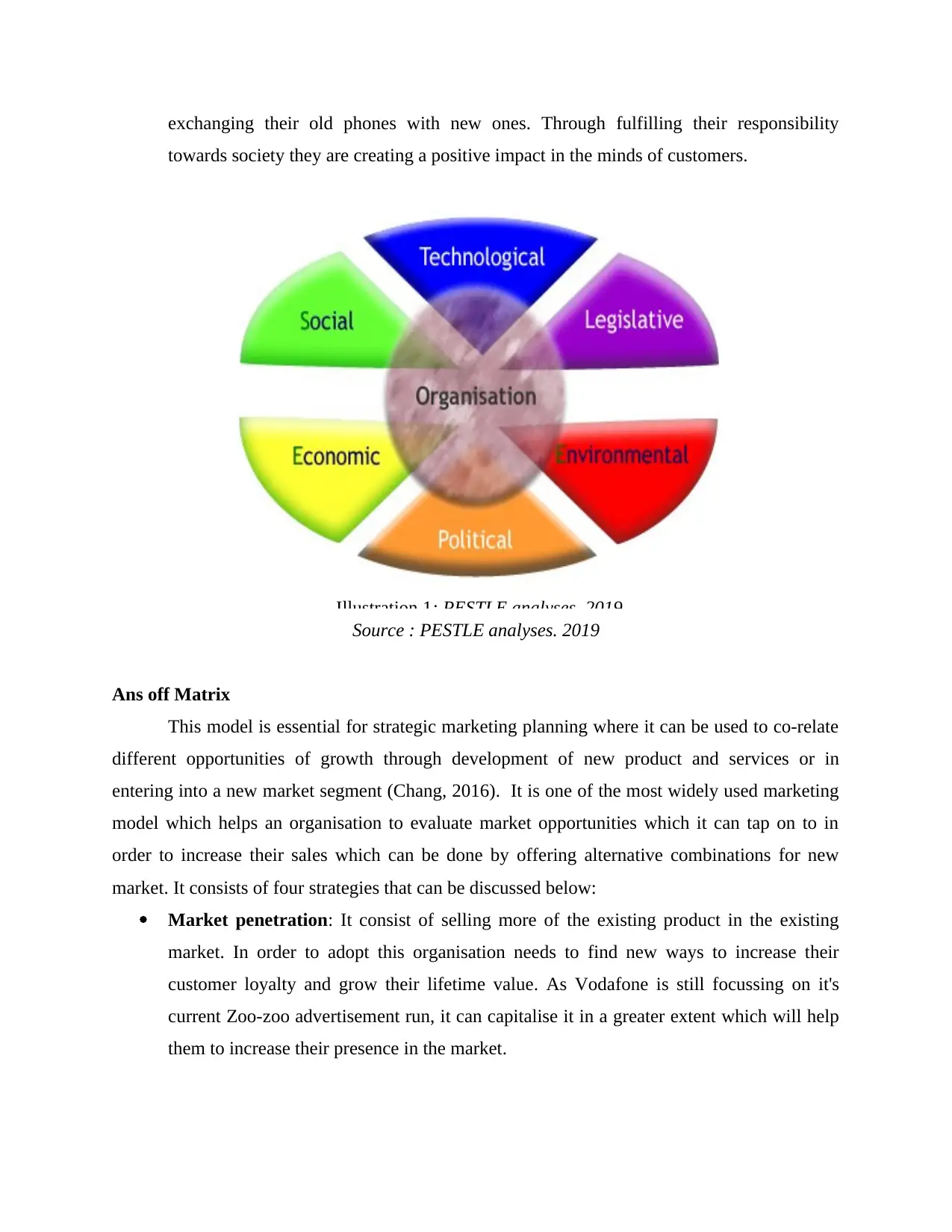
exchanging their old phones with new ones. Through fulfilling their responsibility
towards society they are creating a positive impact in the minds of customers.
Source : PESTLE analyses. 2019
Ans off Matrix
This model is essential for strategic marketing planning where it can be used to co-relate
different opportunities of growth through development of new product and services or in
entering into a new market segment (Chang, 2016). It is one of the most widely used marketing
model which helps an organisation to evaluate market opportunities which it can tap on to in
order to increase their sales which can be done by offering alternative combinations for new
market. It consists of four strategies that can be discussed below:
Market penetration: It consist of selling more of the existing product in the existing
market. In order to adopt this organisation needs to find new ways to increase their
customer loyalty and grow their lifetime value. As Vodafone is still focussing on it's
current Zoo-zoo advertisement run, it can capitalise it in a greater extent which will help
them to increase their presence in the market.
Illustration 1: PESTLE analyses. 2019
towards society they are creating a positive impact in the minds of customers.
Source : PESTLE analyses. 2019
Ans off Matrix
This model is essential for strategic marketing planning where it can be used to co-relate
different opportunities of growth through development of new product and services or in
entering into a new market segment (Chang, 2016). It is one of the most widely used marketing
model which helps an organisation to evaluate market opportunities which it can tap on to in
order to increase their sales which can be done by offering alternative combinations for new
market. It consists of four strategies that can be discussed below:
Market penetration: It consist of selling more of the existing product in the existing
market. In order to adopt this organisation needs to find new ways to increase their
customer loyalty and grow their lifetime value. As Vodafone is still focussing on it's
current Zoo-zoo advertisement run, it can capitalise it in a greater extent which will help
them to increase their presence in the market.
Illustration 1: PESTLE analyses. 2019
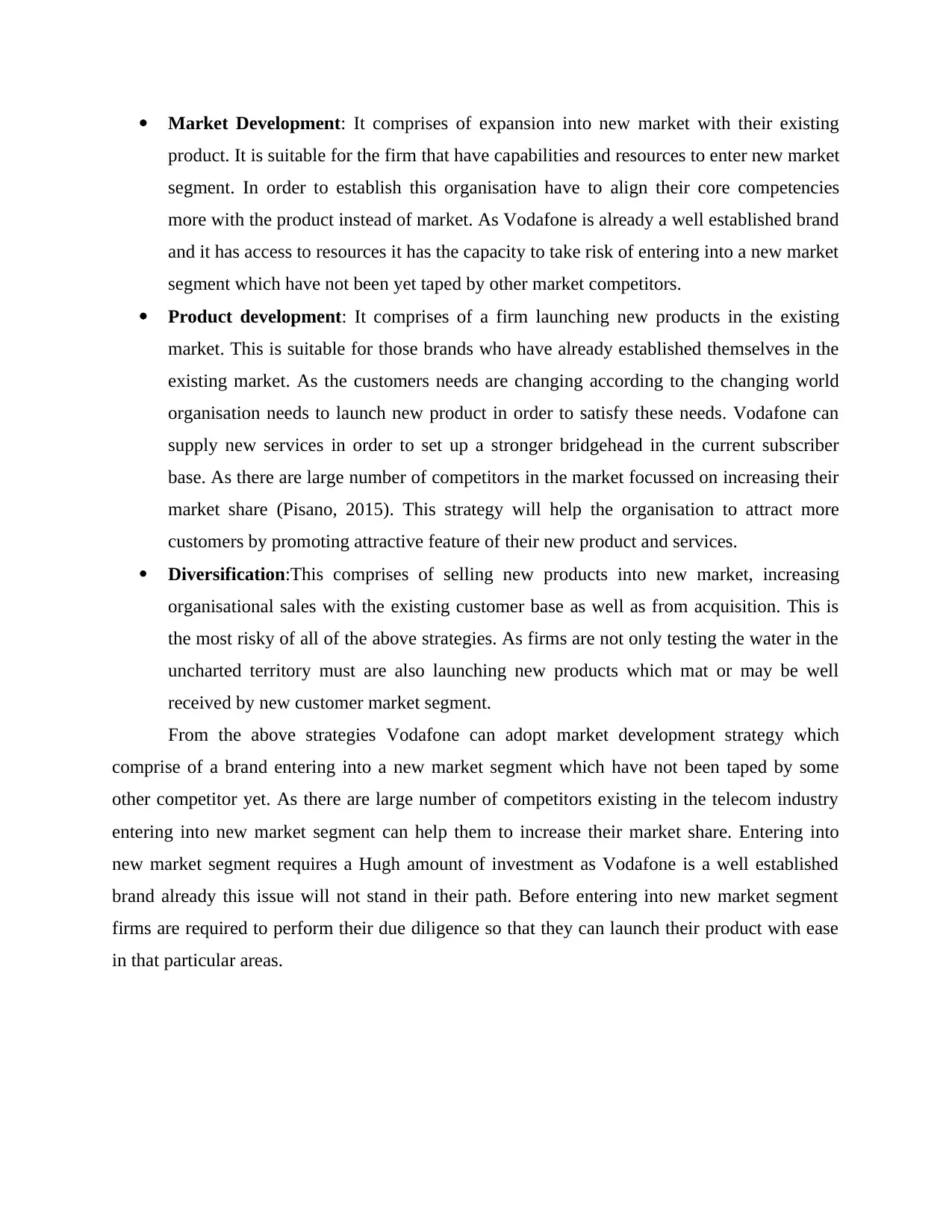
Market Development: It comprises of expansion into new market with their existing
product. It is suitable for the firm that have capabilities and resources to enter new market
segment. In order to establish this organisation have to align their core competencies
more with the product instead of market. As Vodafone is already a well established brand
and it has access to resources it has the capacity to take risk of entering into a new market
segment which have not been yet taped by other market competitors.
Product development: It comprises of a firm launching new products in the existing
market. This is suitable for those brands who have already established themselves in the
existing market. As the customers needs are changing according to the changing world
organisation needs to launch new product in order to satisfy these needs. Vodafone can
supply new services in order to set up a stronger bridgehead in the current subscriber
base. As there are large number of competitors in the market focussed on increasing their
market share (Pisano, 2015). This strategy will help the organisation to attract more
customers by promoting attractive feature of their new product and services.
Diversification:This comprises of selling new products into new market, increasing
organisational sales with the existing customer base as well as from acquisition. This is
the most risky of all of the above strategies. As firms are not only testing the water in the
uncharted territory must are also launching new products which mat or may be well
received by new customer market segment.
From the above strategies Vodafone can adopt market development strategy which
comprise of a brand entering into a new market segment which have not been taped by some
other competitor yet. As there are large number of competitors existing in the telecom industry
entering into new market segment can help them to increase their market share. Entering into
new market segment requires a Hugh amount of investment as Vodafone is a well established
brand already this issue will not stand in their path. Before entering into new market segment
firms are required to perform their due diligence so that they can launch their product with ease
in that particular areas.
product. It is suitable for the firm that have capabilities and resources to enter new market
segment. In order to establish this organisation have to align their core competencies
more with the product instead of market. As Vodafone is already a well established brand
and it has access to resources it has the capacity to take risk of entering into a new market
segment which have not been yet taped by other market competitors.
Product development: It comprises of a firm launching new products in the existing
market. This is suitable for those brands who have already established themselves in the
existing market. As the customers needs are changing according to the changing world
organisation needs to launch new product in order to satisfy these needs. Vodafone can
supply new services in order to set up a stronger bridgehead in the current subscriber
base. As there are large number of competitors in the market focussed on increasing their
market share (Pisano, 2015). This strategy will help the organisation to attract more
customers by promoting attractive feature of their new product and services.
Diversification:This comprises of selling new products into new market, increasing
organisational sales with the existing customer base as well as from acquisition. This is
the most risky of all of the above strategies. As firms are not only testing the water in the
uncharted territory must are also launching new products which mat or may be well
received by new customer market segment.
From the above strategies Vodafone can adopt market development strategy which
comprise of a brand entering into a new market segment which have not been taped by some
other competitor yet. As there are large number of competitors existing in the telecom industry
entering into new market segment can help them to increase their market share. Entering into
new market segment requires a Hugh amount of investment as Vodafone is a well established
brand already this issue will not stand in their path. Before entering into new market segment
firms are required to perform their due diligence so that they can launch their product with ease
in that particular areas.
⊘ This is a preview!⊘
Do you want full access?
Subscribe today to unlock all pages.

Trusted by 1+ million students worldwide
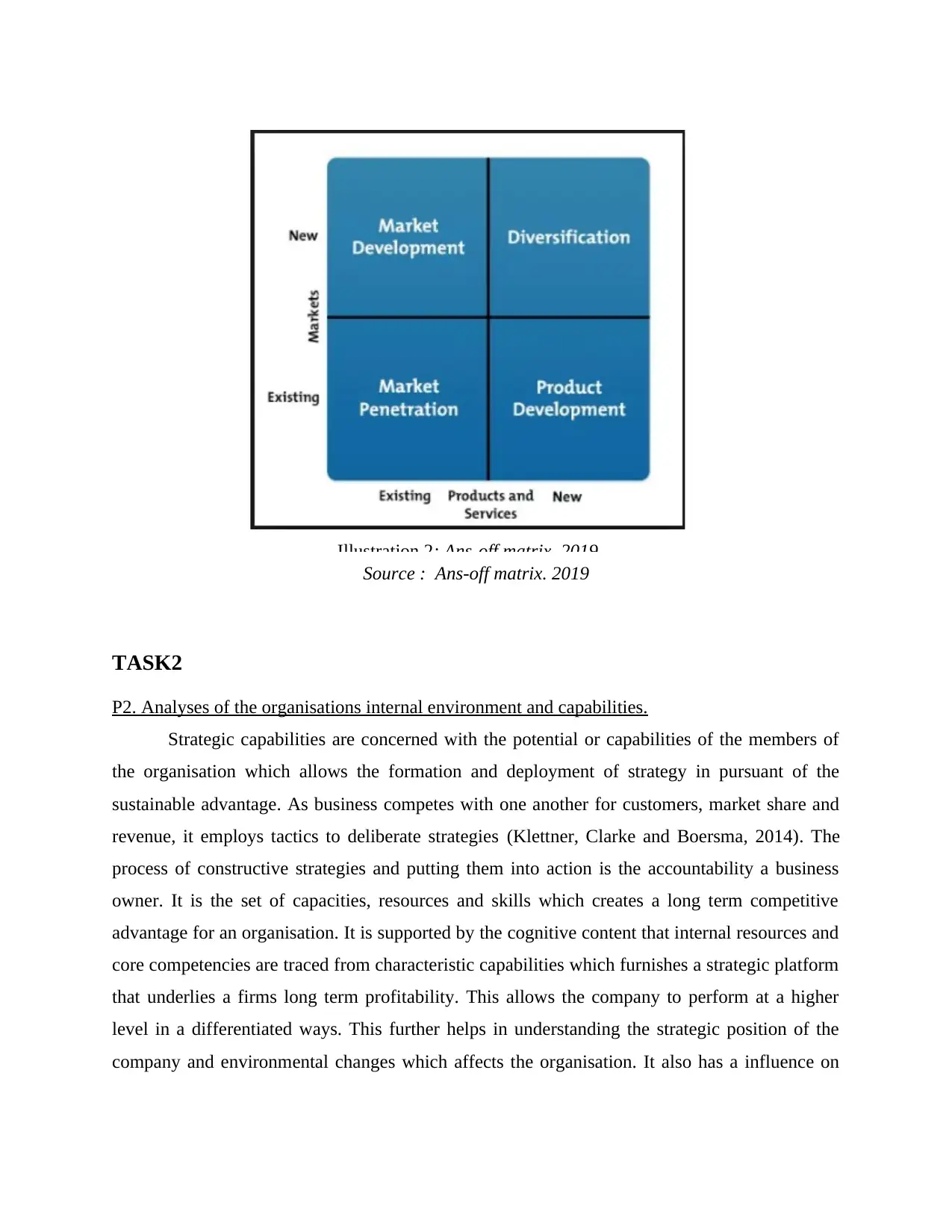
Source : Ans-off matrix. 2019
TASK2
P2. Analyses of the organisations internal environment and capabilities.
Strategic capabilities are concerned with the potential or capabilities of the members of
the organisation which allows the formation and deployment of strategy in pursuant of the
sustainable advantage. As business competes with one another for customers, market share and
revenue, it employs tactics to deliberate strategies (Klettner, Clarke and Boersma, 2014). The
process of constructive strategies and putting them into action is the accountability a business
owner. It is the set of capacities, resources and skills which creates a long term competitive
advantage for an organisation. It is supported by the cognitive content that internal resources and
core competencies are traced from characteristic capabilities which furnishes a strategic platform
that underlies a firms long term profitability. This allows the company to perform at a higher
level in a differentiated ways. This further helps in understanding the strategic position of the
company and environmental changes which affects the organisation. It also has a influence on
Illustration 2: Ans-off matrix. 2019
TASK2
P2. Analyses of the organisations internal environment and capabilities.
Strategic capabilities are concerned with the potential or capabilities of the members of
the organisation which allows the formation and deployment of strategy in pursuant of the
sustainable advantage. As business competes with one another for customers, market share and
revenue, it employs tactics to deliberate strategies (Klettner, Clarke and Boersma, 2014). The
process of constructive strategies and putting them into action is the accountability a business
owner. It is the set of capacities, resources and skills which creates a long term competitive
advantage for an organisation. It is supported by the cognitive content that internal resources and
core competencies are traced from characteristic capabilities which furnishes a strategic platform
that underlies a firms long term profitability. This allows the company to perform at a higher
level in a differentiated ways. This further helps in understanding the strategic position of the
company and environmental changes which affects the organisation. It also has a influence on
Illustration 2: Ans-off matrix. 2019
Paraphrase This Document
Need a fresh take? Get an instant paraphrase of this document with our AI Paraphraser
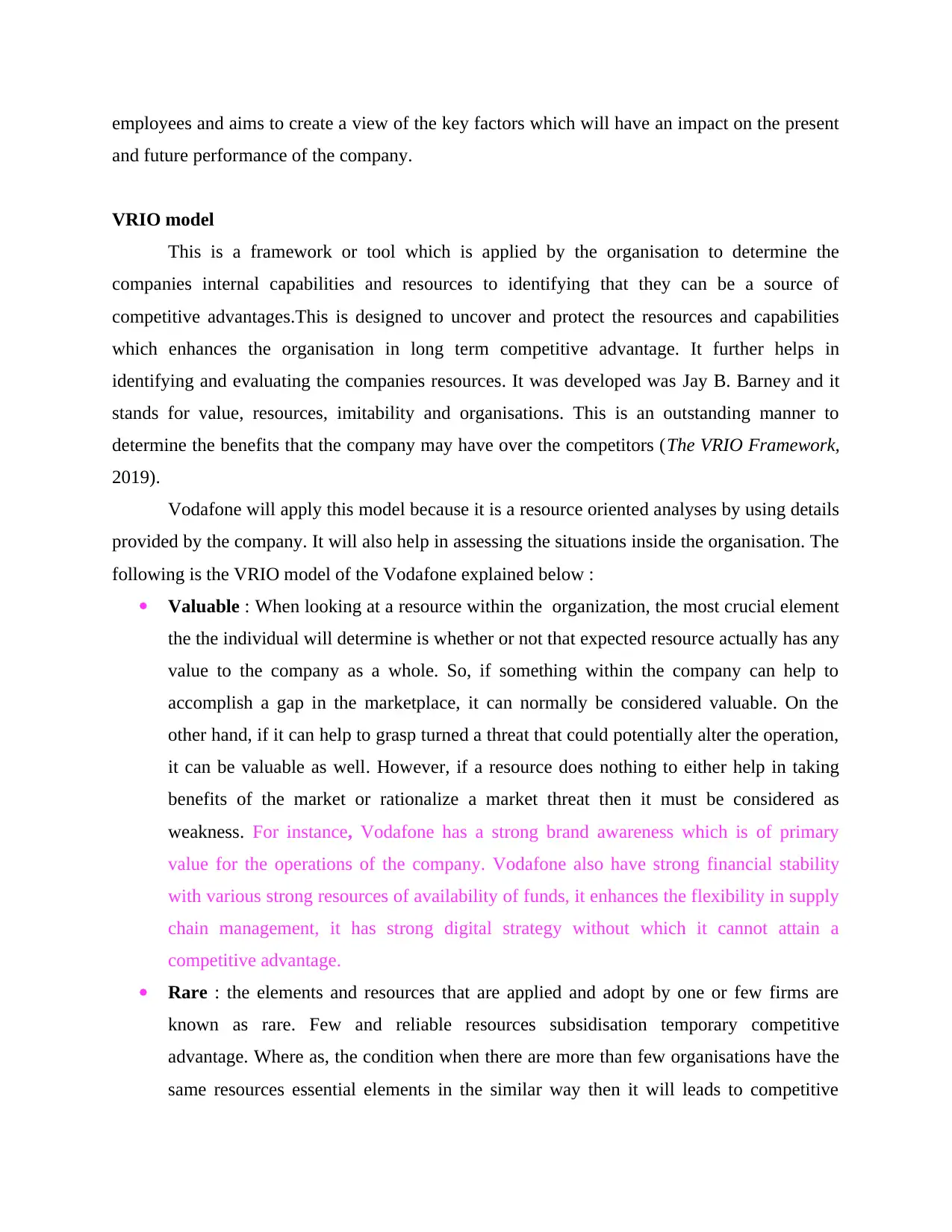
employees and aims to create a view of the key factors which will have an impact on the present
and future performance of the company.
VRIO model
This is a framework or tool which is applied by the organisation to determine the
companies internal capabilities and resources to identifying that they can be a source of
competitive advantages.This is designed to uncover and protect the resources and capabilities
which enhances the organisation in long term competitive advantage. It further helps in
identifying and evaluating the companies resources. It was developed was Jay B. Barney and it
stands for value, resources, imitability and organisations. This is an outstanding manner to
determine the benefits that the company may have over the competitors (The VRIO Framework,
2019).
Vodafone will apply this model because it is a resource oriented analyses by using details
provided by the company. It will also help in assessing the situations inside the organisation. The
following is the VRIO model of the Vodafone explained below :
Valuable : When looking at a resource within the organization, the most crucial element
the the individual will determine is whether or not that expected resource actually has any
value to the company as a whole. So, if something within the company can help to
accomplish a gap in the marketplace, it can normally be considered valuable. On the
other hand, if it can help to grasp turned a threat that could potentially alter the operation,
it can be valuable as well. However, if a resource does nothing to either help in taking
benefits of the market or rationalize a market threat then it must be considered as
weakness. For instance, Vodafone has a strong brand awareness which is of primary
value for the operations of the company. Vodafone also have strong financial stability
with various strong resources of availability of funds, it enhances the flexibility in supply
chain management, it has strong digital strategy without which it cannot attain a
competitive advantage.
Rare : the elements and resources that are applied and adopt by one or few firms are
known as rare. Few and reliable resources subsidisation temporary competitive
advantage. Where as, the condition when there are more than few organisations have the
same resources essential elements in the similar way then it will leads to competitive
and future performance of the company.
VRIO model
This is a framework or tool which is applied by the organisation to determine the
companies internal capabilities and resources to identifying that they can be a source of
competitive advantages.This is designed to uncover and protect the resources and capabilities
which enhances the organisation in long term competitive advantage. It further helps in
identifying and evaluating the companies resources. It was developed was Jay B. Barney and it
stands for value, resources, imitability and organisations. This is an outstanding manner to
determine the benefits that the company may have over the competitors (The VRIO Framework,
2019).
Vodafone will apply this model because it is a resource oriented analyses by using details
provided by the company. It will also help in assessing the situations inside the organisation. The
following is the VRIO model of the Vodafone explained below :
Valuable : When looking at a resource within the organization, the most crucial element
the the individual will determine is whether or not that expected resource actually has any
value to the company as a whole. So, if something within the company can help to
accomplish a gap in the marketplace, it can normally be considered valuable. On the
other hand, if it can help to grasp turned a threat that could potentially alter the operation,
it can be valuable as well. However, if a resource does nothing to either help in taking
benefits of the market or rationalize a market threat then it must be considered as
weakness. For instance, Vodafone has a strong brand awareness which is of primary
value for the operations of the company. Vodafone also have strong financial stability
with various strong resources of availability of funds, it enhances the flexibility in supply
chain management, it has strong digital strategy without which it cannot attain a
competitive advantage.
Rare : the elements and resources that are applied and adopt by one or few firms are
known as rare. Few and reliable resources subsidisation temporary competitive
advantage. Where as, the condition when there are more than few organisations have the
same resources essential elements in the similar way then it will leads to competitive
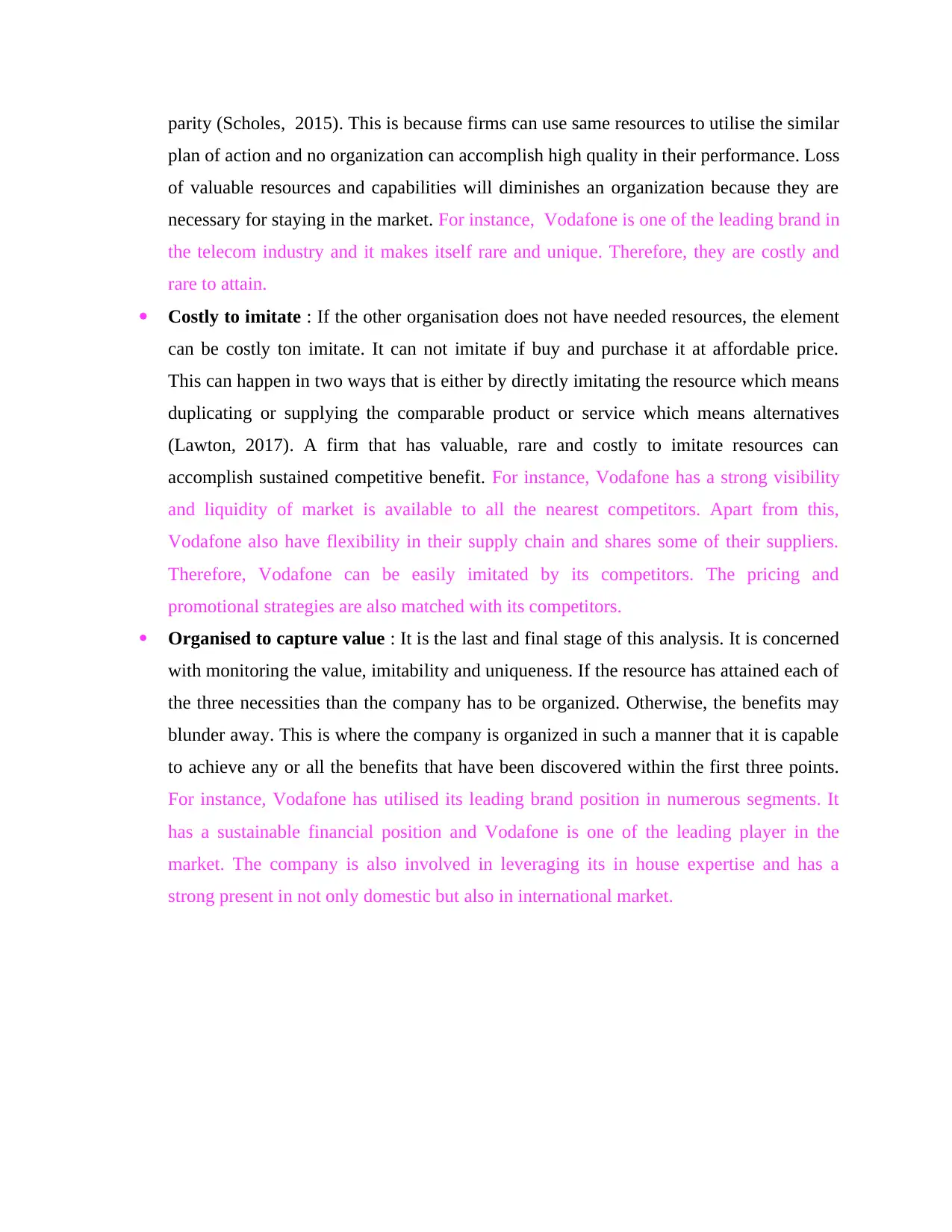
parity (Scholes, 2015). This is because firms can use same resources to utilise the similar
plan of action and no organization can accomplish high quality in their performance. Loss
of valuable resources and capabilities will diminishes an organization because they are
necessary for staying in the market. For instance, Vodafone is one of the leading brand in
the telecom industry and it makes itself rare and unique. Therefore, they are costly and
rare to attain.
Costly to imitate : If the other organisation does not have needed resources, the element
can be costly ton imitate. It can not imitate if buy and purchase it at affordable price.
This can happen in two ways that is either by directly imitating the resource which means
duplicating or supplying the comparable product or service which means alternatives
(Lawton, 2017). A firm that has valuable, rare and costly to imitate resources can
accomplish sustained competitive benefit. For instance, Vodafone has a strong visibility
and liquidity of market is available to all the nearest competitors. Apart from this,
Vodafone also have flexibility in their supply chain and shares some of their suppliers.
Therefore, Vodafone can be easily imitated by its competitors. The pricing and
promotional strategies are also matched with its competitors.
Organised to capture value : It is the last and final stage of this analysis. It is concerned
with monitoring the value, imitability and uniqueness. If the resource has attained each of
the three necessities than the company has to be organized. Otherwise, the benefits may
blunder away. This is where the company is organized in such a manner that it is capable
to achieve any or all the benefits that have been discovered within the first three points.
For instance, Vodafone has utilised its leading brand position in numerous segments. It
has a sustainable financial position and Vodafone is one of the leading player in the
market. The company is also involved in leveraging its in house expertise and has a
strong present in not only domestic but also in international market.
plan of action and no organization can accomplish high quality in their performance. Loss
of valuable resources and capabilities will diminishes an organization because they are
necessary for staying in the market. For instance, Vodafone is one of the leading brand in
the telecom industry and it makes itself rare and unique. Therefore, they are costly and
rare to attain.
Costly to imitate : If the other organisation does not have needed resources, the element
can be costly ton imitate. It can not imitate if buy and purchase it at affordable price.
This can happen in two ways that is either by directly imitating the resource which means
duplicating or supplying the comparable product or service which means alternatives
(Lawton, 2017). A firm that has valuable, rare and costly to imitate resources can
accomplish sustained competitive benefit. For instance, Vodafone has a strong visibility
and liquidity of market is available to all the nearest competitors. Apart from this,
Vodafone also have flexibility in their supply chain and shares some of their suppliers.
Therefore, Vodafone can be easily imitated by its competitors. The pricing and
promotional strategies are also matched with its competitors.
Organised to capture value : It is the last and final stage of this analysis. It is concerned
with monitoring the value, imitability and uniqueness. If the resource has attained each of
the three necessities than the company has to be organized. Otherwise, the benefits may
blunder away. This is where the company is organized in such a manner that it is capable
to achieve any or all the benefits that have been discovered within the first three points.
For instance, Vodafone has utilised its leading brand position in numerous segments. It
has a sustainable financial position and Vodafone is one of the leading player in the
market. The company is also involved in leveraging its in house expertise and has a
strong present in not only domestic but also in international market.
⊘ This is a preview!⊘
Do you want full access?
Subscribe today to unlock all pages.

Trusted by 1+ million students worldwide
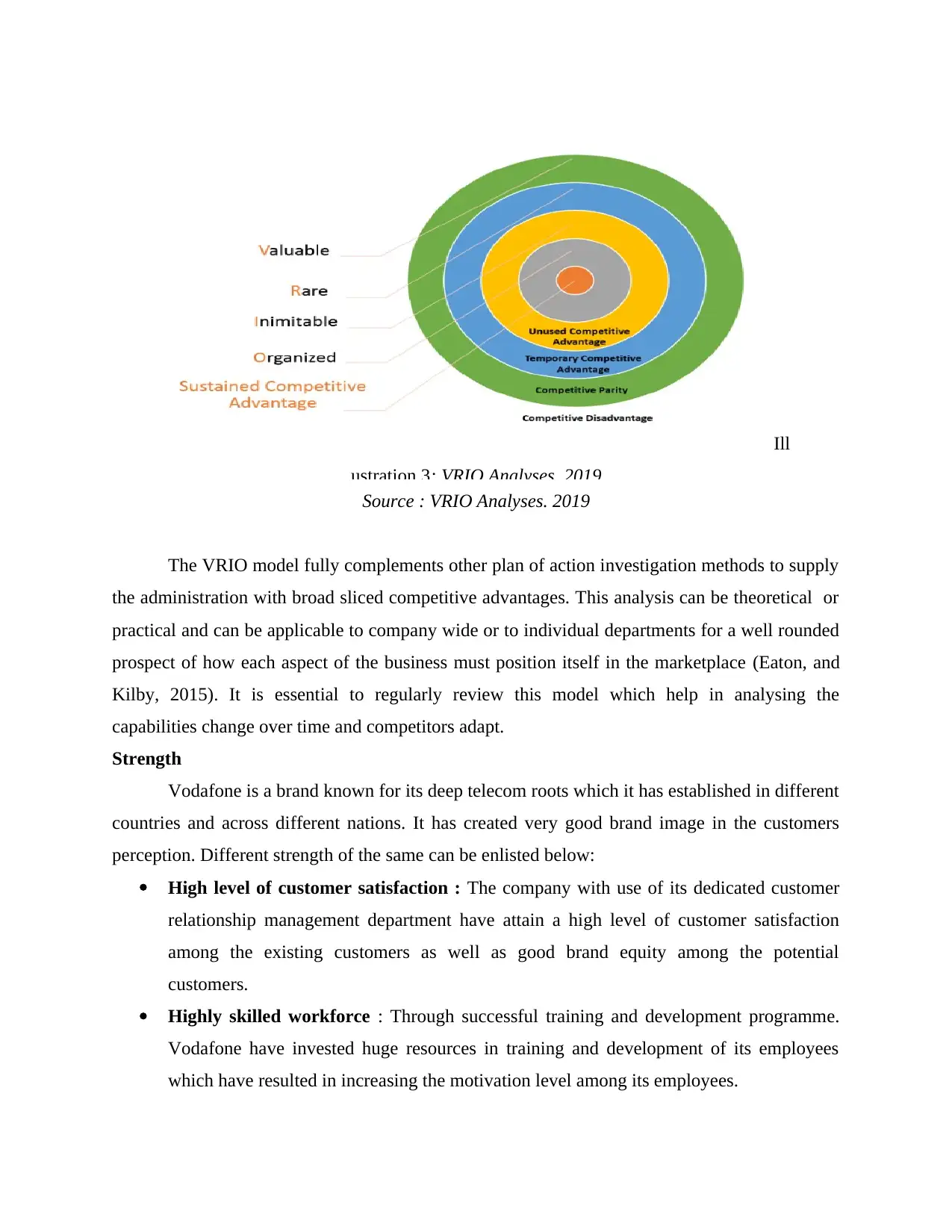
Source : VRIO Analyses. 2019
The VRIO model fully complements other plan of action investigation methods to supply
the administration with broad sliced competitive advantages. This analysis can be theoretical or
practical and can be applicable to company wide or to individual departments for a well rounded
prospect of how each aspect of the business must position itself in the marketplace (Eaton, and
Kilby, 2015). It is essential to regularly review this model which help in analysing the
capabilities change over time and competitors adapt.
Strength
Vodafone is a brand known for its deep telecom roots which it has established in different
countries and across different nations. It has created very good brand image in the customers
perception. Different strength of the same can be enlisted below:
High level of customer satisfaction : The company with use of its dedicated customer
relationship management department have attain a high level of customer satisfaction
among the existing customers as well as good brand equity among the potential
customers.
Highly skilled workforce : Through successful training and development programme.
Vodafone have invested huge resources in training and development of its employees
which have resulted in increasing the motivation level among its employees.
Ill
ustration 3: VRIO Analyses. 2019
The VRIO model fully complements other plan of action investigation methods to supply
the administration with broad sliced competitive advantages. This analysis can be theoretical or
practical and can be applicable to company wide or to individual departments for a well rounded
prospect of how each aspect of the business must position itself in the marketplace (Eaton, and
Kilby, 2015). It is essential to regularly review this model which help in analysing the
capabilities change over time and competitors adapt.
Strength
Vodafone is a brand known for its deep telecom roots which it has established in different
countries and across different nations. It has created very good brand image in the customers
perception. Different strength of the same can be enlisted below:
High level of customer satisfaction : The company with use of its dedicated customer
relationship management department have attain a high level of customer satisfaction
among the existing customers as well as good brand equity among the potential
customers.
Highly skilled workforce : Through successful training and development programme.
Vodafone have invested huge resources in training and development of its employees
which have resulted in increasing the motivation level among its employees.
Ill
ustration 3: VRIO Analyses. 2019
Paraphrase This Document
Need a fresh take? Get an instant paraphrase of this document with our AI Paraphraser
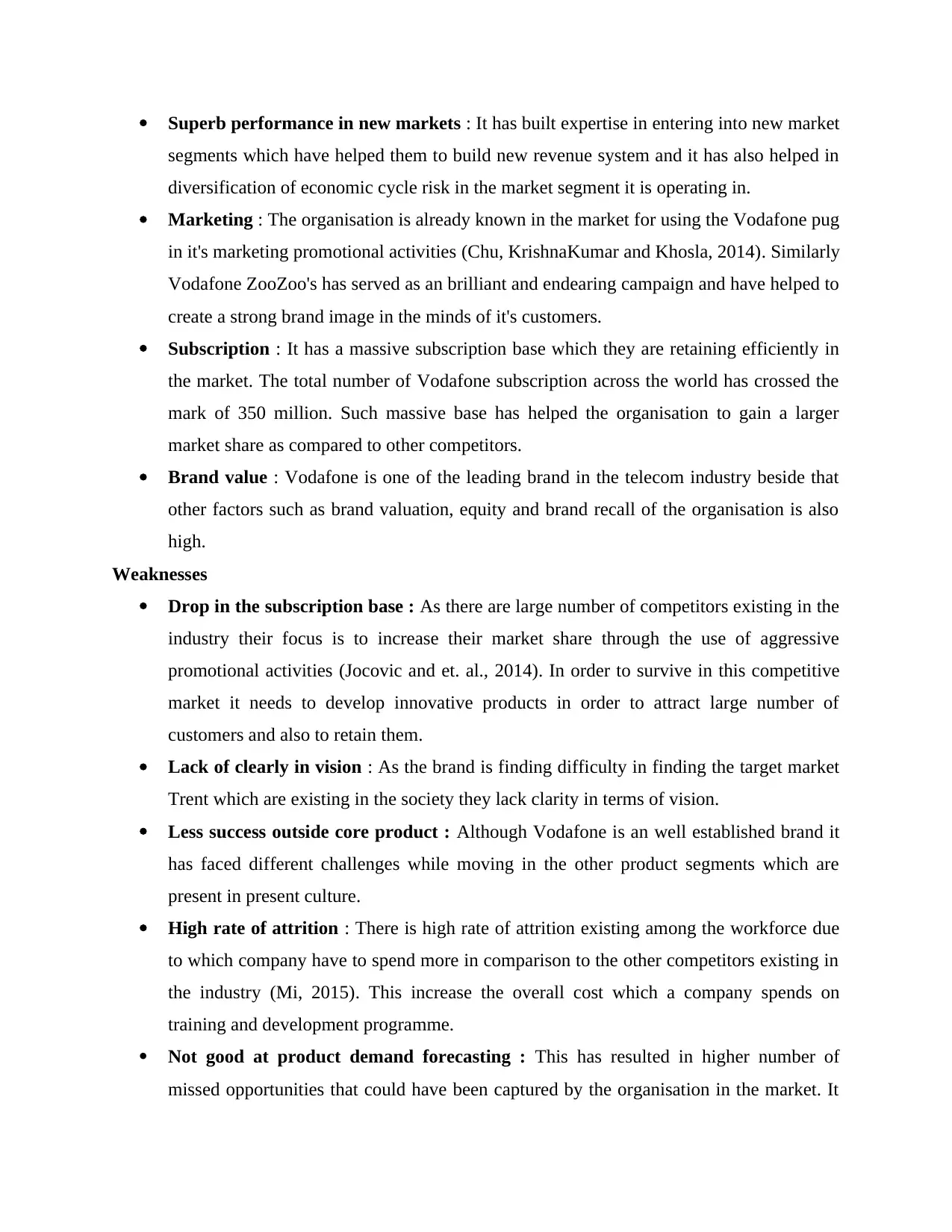
Superb performance in new markets : It has built expertise in entering into new market
segments which have helped them to build new revenue system and it has also helped in
diversification of economic cycle risk in the market segment it is operating in.
Marketing : The organisation is already known in the market for using the Vodafone pug
in it's marketing promotional activities (Chu, KrishnaKumar and Khosla, 2014). Similarly
Vodafone ZooZoo's has served as an brilliant and endearing campaign and have helped to
create a strong brand image in the minds of it's customers.
Subscription : It has a massive subscription base which they are retaining efficiently in
the market. The total number of Vodafone subscription across the world has crossed the
mark of 350 million. Such massive base has helped the organisation to gain a larger
market share as compared to other competitors.
Brand value : Vodafone is one of the leading brand in the telecom industry beside that
other factors such as brand valuation, equity and brand recall of the organisation is also
high.
Weaknesses
Drop in the subscription base : As there are large number of competitors existing in the
industry their focus is to increase their market share through the use of aggressive
promotional activities (Jocovic and et. al., 2014). In order to survive in this competitive
market it needs to develop innovative products in order to attract large number of
customers and also to retain them.
Lack of clearly in vision : As the brand is finding difficulty in finding the target market
Trent which are existing in the society they lack clarity in terms of vision.
Less success outside core product : Although Vodafone is an well established brand it
has faced different challenges while moving in the other product segments which are
present in present culture.
High rate of attrition : There is high rate of attrition existing among the workforce due
to which company have to spend more in comparison to the other competitors existing in
the industry (Mi, 2015). This increase the overall cost which a company spends on
training and development programme.
Not good at product demand forecasting : This has resulted in higher number of
missed opportunities that could have been captured by the organisation in the market. It
segments which have helped them to build new revenue system and it has also helped in
diversification of economic cycle risk in the market segment it is operating in.
Marketing : The organisation is already known in the market for using the Vodafone pug
in it's marketing promotional activities (Chu, KrishnaKumar and Khosla, 2014). Similarly
Vodafone ZooZoo's has served as an brilliant and endearing campaign and have helped to
create a strong brand image in the minds of it's customers.
Subscription : It has a massive subscription base which they are retaining efficiently in
the market. The total number of Vodafone subscription across the world has crossed the
mark of 350 million. Such massive base has helped the organisation to gain a larger
market share as compared to other competitors.
Brand value : Vodafone is one of the leading brand in the telecom industry beside that
other factors such as brand valuation, equity and brand recall of the organisation is also
high.
Weaknesses
Drop in the subscription base : As there are large number of competitors existing in the
industry their focus is to increase their market share through the use of aggressive
promotional activities (Jocovic and et. al., 2014). In order to survive in this competitive
market it needs to develop innovative products in order to attract large number of
customers and also to retain them.
Lack of clearly in vision : As the brand is finding difficulty in finding the target market
Trent which are existing in the society they lack clarity in terms of vision.
Less success outside core product : Although Vodafone is an well established brand it
has faced different challenges while moving in the other product segments which are
present in present culture.
High rate of attrition : There is high rate of attrition existing among the workforce due
to which company have to spend more in comparison to the other competitors existing in
the industry (Mi, 2015). This increase the overall cost which a company spends on
training and development programme.
Not good at product demand forecasting : This has resulted in higher number of
missed opportunities that could have been captured by the organisation in the market. It
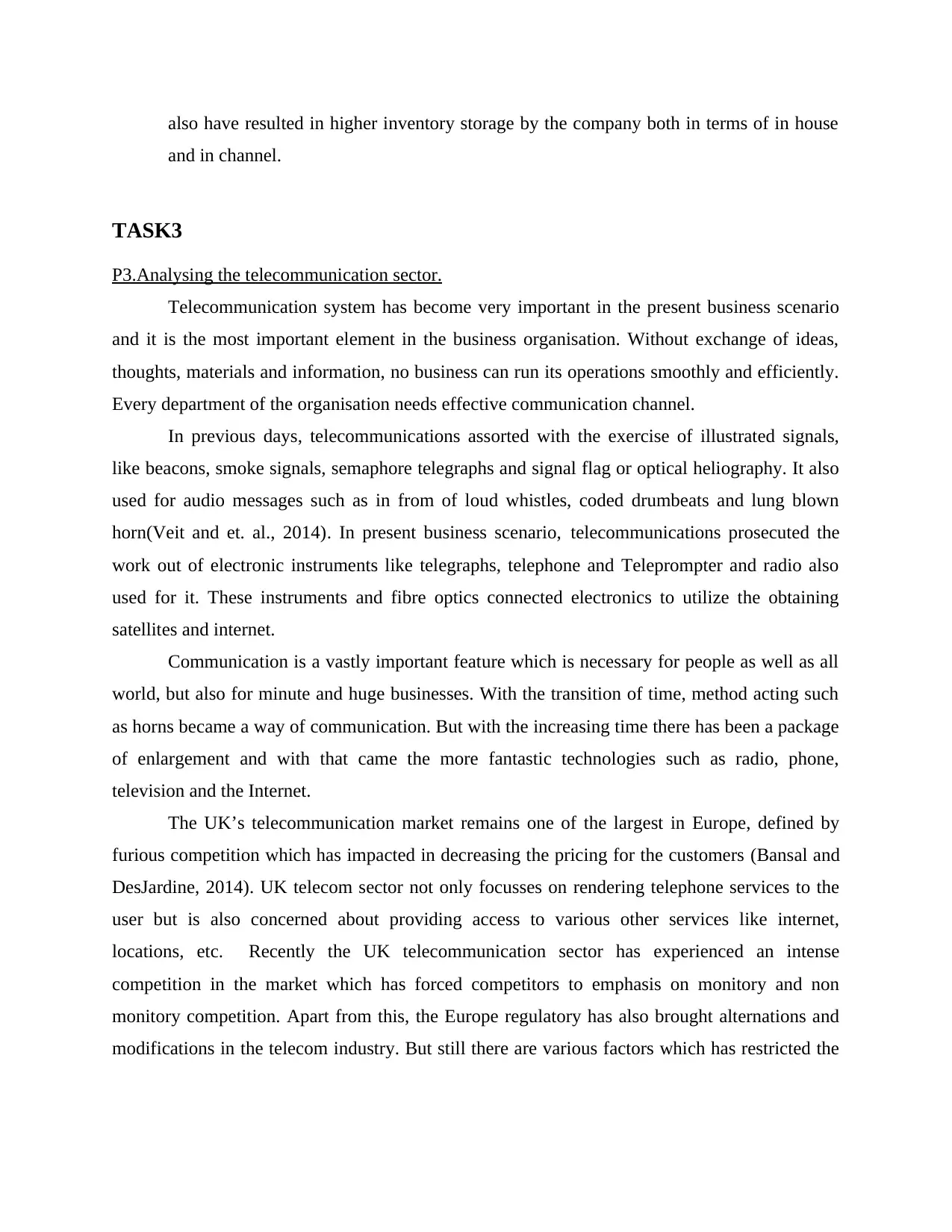
also have resulted in higher inventory storage by the company both in terms of in house
and in channel.
TASK3
P3.Analysing the telecommunication sector.
Telecommunication system has become very important in the present business scenario
and it is the most important element in the business organisation. Without exchange of ideas,
thoughts, materials and information, no business can run its operations smoothly and efficiently.
Every department of the organisation needs effective communication channel.
In previous days, telecommunications assorted with the exercise of illustrated signals,
like beacons, smoke signals, semaphore telegraphs and signal flag or optical heliography. It also
used for audio messages such as in from of loud whistles, coded drumbeats and lung blown
horn(Veit and et. al., 2014). In present business scenario, telecommunications prosecuted the
work out of electronic instruments like telegraphs, telephone and Teleprompter and radio also
used for it. These instruments and fibre optics connected electronics to utilize the obtaining
satellites and internet.
Communication is a vastly important feature which is necessary for people as well as all
world, but also for minute and huge businesses. With the transition of time, method acting such
as horns became a way of communication. But with the increasing time there has been a package
of enlargement and with that came the more fantastic technologies such as radio, phone,
television and the Internet.
The UK’s telecommunication market remains one of the largest in Europe, defined by
furious competition which has impacted in decreasing the pricing for the customers (Bansal and
DesJardine, 2014). UK telecom sector not only focusses on rendering telephone services to the
user but is also concerned about providing access to various other services like internet,
locations, etc. Recently the UK telecommunication sector has experienced an intense
competition in the market which has forced competitors to emphasis on monitory and non
monitory competition. Apart from this, the Europe regulatory has also brought alternations and
modifications in the telecom industry. But still there are various factors which has restricted the
and in channel.
TASK3
P3.Analysing the telecommunication sector.
Telecommunication system has become very important in the present business scenario
and it is the most important element in the business organisation. Without exchange of ideas,
thoughts, materials and information, no business can run its operations smoothly and efficiently.
Every department of the organisation needs effective communication channel.
In previous days, telecommunications assorted with the exercise of illustrated signals,
like beacons, smoke signals, semaphore telegraphs and signal flag or optical heliography. It also
used for audio messages such as in from of loud whistles, coded drumbeats and lung blown
horn(Veit and et. al., 2014). In present business scenario, telecommunications prosecuted the
work out of electronic instruments like telegraphs, telephone and Teleprompter and radio also
used for it. These instruments and fibre optics connected electronics to utilize the obtaining
satellites and internet.
Communication is a vastly important feature which is necessary for people as well as all
world, but also for minute and huge businesses. With the transition of time, method acting such
as horns became a way of communication. But with the increasing time there has been a package
of enlargement and with that came the more fantastic technologies such as radio, phone,
television and the Internet.
The UK’s telecommunication market remains one of the largest in Europe, defined by
furious competition which has impacted in decreasing the pricing for the customers (Bansal and
DesJardine, 2014). UK telecom sector not only focusses on rendering telephone services to the
user but is also concerned about providing access to various other services like internet,
locations, etc. Recently the UK telecommunication sector has experienced an intense
competition in the market which has forced competitors to emphasis on monitory and non
monitory competition. Apart from this, the Europe regulatory has also brought alternations and
modifications in the telecom industry. But still there are various factors which has restricted the
⊘ This is a preview!⊘
Do you want full access?
Subscribe today to unlock all pages.

Trusted by 1+ million students worldwide
1 out of 20
Related Documents
Your All-in-One AI-Powered Toolkit for Academic Success.
+13062052269
info@desklib.com
Available 24*7 on WhatsApp / Email
![[object Object]](/_next/static/media/star-bottom.7253800d.svg)
Unlock your academic potential
Copyright © 2020–2025 A2Z Services. All Rights Reserved. Developed and managed by ZUCOL.





